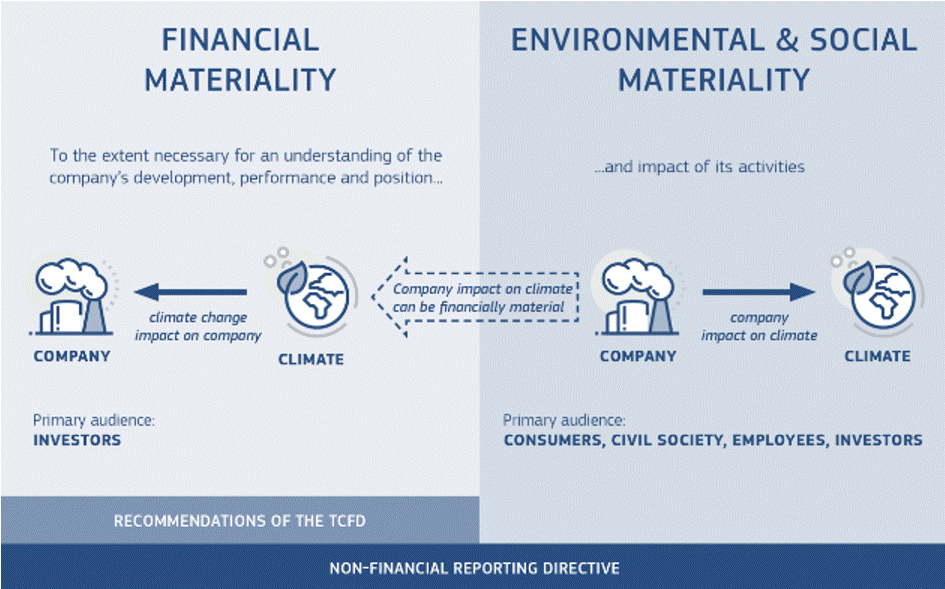Introducing the Concept of Double Materiality
Tackling the climate crisis will require transformational change and substantial effort within the corporate sector, the investment sector and society at large. Such is the case not only for the climate crisis, but also biodiversity loss, global water scarcity, deforestation, inequalities and Human Rights. If the corporate community and the financial sector are to play their part in addressing these interwoven social and environmental crises, enforcing new legal requirements that effectively level the playing field is both necessary and inevitable – which is why the exercise of double materiality.
In 2019, the European Union adopted the Sustainable Finance Disclosure Regulation. It requires investors to disclose their adverse impacts on both the planet and society. In that regard, the concept of double materiality speaks to the fact that risks and opportunities can be material from both a financial and non-financial perspective. In other words, double materiality recognizes that:
- On the one hand, companies and financial institutions are responsible for managing the financial risk socio-environmental factors generate for their bottom line ;
- On the other, the very same companies and financial institutions must manage and take responsibility for the actual and potential adverse impacts of their decisions on people, society and the environment;
The EU Green Taxonomy – and upcoming CSRD – both confirm double materiality as the basis for comprehensive non-financial information disclosure.
Value and Limitations of Materiality to Date
We at Ksapa have designed and updated materiality analyses for numerous Fortune 500 and financial institutions in the past decade. Together, we explored and tested multiple methodologies ranging from purely qualitative to fully quantitative approaches.
While materiality analyses are never easy and can still gain in robustness, the present document shares valuable contributions to help corporations and financial institutions focus on the most strategic environmental, social and ethical issues. That way, we hope to help them identify the necessary management modalities, to drive transformation and meet stakeholder expectations
THE MANY POSITIVE CONTRIBUTIONS OF MATERIALITY
Materiality has proven to be useful for companies and financial institutions for the following reasons – at the very least:
– Expands scope to better understand all the dimensions of business performance
Defined from the perspective of the impact of an organization on sustainable development and stakeholders, materiality increases companies’ focus on sustainability. This helps decision-makers better apprehend why performing on several sustainability issues is supportive of business performance
– Builds internal alignment on action plans to support business priorities and address stakeholder expectations
An organization’s identification of issues both financially material or material to enterprise value is incomplete unless it first reviews its material impacts on sustainable development.
Materiality clearly established why improving on select sustainability issues is good for business. It supports internal alignment, for decision-makers to take sustainability seriously as part of fulfilling the goals of their overarching plans.
– Enables better stakeholder engagement
Applying the materiality concept provides a clear rationale on the most relevant issues. This helps companies better understand and ultimately focus on why certain issues require resources and time to engage stakeholders.
For stakeholders, materiality assessments also provide a useful perspective to zero in on the issues certain companies may be interested in, to partake in a shared agenda.
– Nurtures purpose and employee engagement
Focusing on value for the organization, society and the environment rather than financial materiality alone helps organizations engage with the United Nations’ SDG.
Materiality helps connect corporate mission statements (e.g. “we design innovative solutions to increase productivity of our clients”) with their broader responsibility of addressing urgent collective needs (e.g. “we deliver solutions for our clients to use less resources and energy – which is good for the planet and for our development”).
– Drives collective action towards the SDG
Corporate reports that address sustainable development issues material to their organizations help educate and influence the broader society on sustainable development.
A decade’s worth of materiality assessments relentlessly listed climate issues as material for all organizations. This convinced the latter to engage in coalitions and support climate regulations.
– Connects non-financial performance and financial valuation
Disclosing material sustainability issues is relevant to value creation. Several data-based studies demonstrate the direct correlation of non-financial materiality, non-financial issue management and better financial valuation
– Streamlines resources
Materiality assessments enhance decision-making, for instance with regards to resource allocation.
Companies tend to consider they lack the resources necessary to lead sustainability programs. Before exploring ways to reign in additional resources, materiality helps revisit the allocation of existing resources to target the most material issues. This can come at the expense of programs that fail to contribute positively to material issues
THE LIMITATIONS OF MATERIALITY
Combining decades’ worth of expertise and perspectives from both practitioners and academia, Ksapa is well poised to summarize the pros and cons of materiality. We use the materiality tool because we find it useful on the whole. That said, we conduct these exercises bearing in mind certain limitations :
– The absence of a standardized one-size-fits-all methodology
Materiality approaches vary considerably from one company to another. Where they prioritize mostly financially material issues, the process is rendered less robust.
– Insufficient transparency guiding conclusions
Failing to disclose the process for determining material issues reduces the perceived credibility of materiality exercises.
– The absence of third-party verification
Materiality analysis and disclosure approaches are often not included in the scope of assurance engagements. Assurance engagements of sustainability information indeed focus primarily on verifying data.
– Inaccessibility for SMEs
90% of companies are SMEs, which do not typically carry out materiality analyses – except via business associations, for instance. Simplified approaches and guidance would be helpful to empower them to conduct materiality exercises.
Double Materiality Diversifies Perspectives to the Benefit of Organizations
A materiality exercise helps a company to understand and address stakeholder concerns. It also allows it to better factor sustainability to improve its own business performance. This is a good start to educate one’s business community on sustainability. Yet it is not enough to secure the actual resilience of that business.
To achieve that goal, organizations must exert enough transformative pressure to contribute to the sustainability agenda with the necessary urgency. This is all the more essential as collective progress against sustainability goals is woefully insufficient to date. Most critical perspectives on materiality would even conclude that traditional materiality analyses somewhat fail to challenge the dominant business ideology of pursuing economic growth rather than promote more sustainable consumption patterns.
THE DOUBLE MATERIALITY NUANCES THE COMPANIES’ ANALYSIS
Double materiality offers a degree of nuance on the matter, as demonstrated in the following example. The materiality analysis of a food company could indeed point to the importance of enforcing greater traceability across its ingredients. Because it is better for business to secure price and quality. Because customers have increasingly come to expect that level of information. Yet the company may not consider it necessarily “material” whether and why the sourcing of a given ingredient could have a particularly adverse impact for the planet and society.
A DRIVER FOR CHANGE
Double materiality encourages a change of perspective. It helps companies adopt a nuanced approach, exploring the actual impact of producing key ingredients across its extended supply chain. In fact, that particular production may compete with other crops and encourage smallholders to produce export crops exclusively – at the expense of their own livelihood. A double materiality analysis is therefore key to broader corporate understanding, pushing it towards concluding it is material to strengthen traceability… as much as bolstering intercropping and diversification at farm level. Double materiality further challenges a company or financial institution to better understand how to tackle certain material issues, in a way that drives disruptive transformations. In so doing, it not only shores up its license to operate, it also helps the company live up to its responsibility. That is, to drive societal changes across the systemic issues in which it has a clear material stake.
Tackling Double Materiality in Practical Terms
The Non-Financial Reporting Directive (NFRD) now expects companies and financial institutions to adopt this a dual materiality perspective. It even developed the following chart to articulate the goals of double materiality for different audiences.

The European Financial Reporting Advisory Group defines double materiality as the combination of ‘financial materiality’ and ‘impact materiality’. In that regard, impact materiality involves “identifying sustainability matters that are material in terms of the impacts of the reporting entity’s own operations and its value chain (EFRAG, 2021, p8), based on:
- The severity (scale, scope and remendability) and, if appropriate, likelihood of actual and potential negative impacts on people and the environment;
- The scale, scope and likelihood of actual positive impacts on people and the environment in relations to a company’s operations and value chain;
- The urgency derived from social or environmental public policy and planetary boundaries.
Based on Ksapa’s extensive experience of applying the NFRD, here are 3 key questions to guide companies and financial institutions toward applying double materiality to its full potential and start embedding the concept in their assessments and reporting processes.
1) How does the NFRD (soon substituted by the CSRD) articulate double materiality?
The NFRD provides the following guidance:
- Financial materiality. This exercise explores, in the broad sense, which socio-environmental issues affect corporate value the most. For instance, climate-related information should be disclosed if it supports a better understanding of the development, performance and position of the company. Such perspectives are typically of key interest to investors.
- Socio-Environmental Materiality. This exercises explores, in the broad sense, which socio-environmental are most impacted by corporate activities. This basically summarizes how conventional materiality analyses have been carried out for more than a decade. For instance, climate-related information should be disclosed if it supports a better understanding of a company’s external impacts. Such perspectives are typically of key interest to citizens, consumers, employees, business partners, communities and civil society organizations. However, an increasing number of investors are equally keen to understand the climate impacts of their investees, to better anticipate and measure the climate impacts of their investment portfolio overall.
2) Does a company need to explore double materiality in relations to every issue?
Companies can run a materiality analysis across 10, 50 or 150 sustainability issues. They also can apply it to a variety of operations (at corporate, business unit or market level, for instance). It is entirely up to the company to decide whether each sustainability issue should be explored from a financial or impact materiality perspective – or both. Here is the rationale for applying double materiality. This should be adapted and specified in a transparent methodological note available to stakeholders:
- The two perspectives may overlap in some cases. Given they are increasingly likely to do so in the future, there is no need to conduct a dual assessment. Only when there is a clear need for dual perspective;
- As markets and public policies evolve to address select sustainability issues, the positive and/or negative impacts of a company will increasingly offer business opportunities and/or risks. They are both financially material. Should a given issue offer a direct connection between financial and non-financial materiality, there is again no need to explore it from a dual perspective. As for climate, the materiality perspective of the NFRD covers both financial and socio-environmental materiality. By contrast, the TCFD prioritizes a financial materiality perspective, for instance.
3) How should double materiality exercises be calibrated in the short and long term?
A materiality assessment is generally designed to drive a 3-5 year sustainability strategy. Conversely, financial materiality analyses span much longer horizons (e.g. asset management strategies over 10+ years). As such, it is important to match timeframes.
Here are a few methodological pointers for organizations to conduct double materiality with a long-term perspective:
- Companies should cover their entire value chain, both upstream and downstream, in their assessments.
- Companies should pinpoint a relevant and specific set of sustainability issues. In that sense, it makes little sense to explore climate-related impacts, which obviously have longer term impacts on both dimensions. Instead, narrowing down the issues – like biomass feedstock or the cost of charging EV batteries – may offer more concrete insights.
Conclusion: Contrasting Approaches on Both Sides of the Atlantic
Double materiality effectively raises the bar. It ensures corporate and financial institutions to address their sustainability agenda with the right level of understanding and ambition.
Double materiality aptly strengthens their analyses and outcomes. It aligns investors and other stakeholders on a company’s role with regards to the broader sustainability agenda. That said, several challenges outlined in this paper have yet to be fully resolved. Otherwise they may become even more complicated in the coming years. This is likely a key reason why there is an apparently growing divide between European and American markets over the issue of double materiality.
- On the one hand, global standard-setting organizations (such as the IFRS Foundation or the SASB) are rather favorable to covering only the socio-environmental impacts exerted on companies. Their primary goal is indeed to inform investors on the risks they incur.
- For its part, the European Union seeks to base its non-financial reporting framework on a principle of double materiality. As such, it would analyze both the impact of ESG risks on the company and the impact of the company on society at large.
Given these nuances, Ksapa outlines the following 3-step approach. It ensures compliance with most standards and address a variety of stakeholder concerns:
1. Conduct a conventional materiality assessment that complies with IFRS and SASB standards (e.g. Environmental and Social Materiality, as per NFRD guidance);
2. Conduct a financial materiality based on the same list of socio-environmental issues;
3. Explore commonalities and differences across the two resulting materiality analyses:
- Converging issues mark a clear urgency for a company to issue a bold transformation plan as a means to address these very issues;
- Where issues are mostly material from a financial standpoint but not necessarily in a purely socio-environmental perspective, a company is expected to design an action plan complete with risk mitigation measures from a financial standpoint (e.g. provisioning, de-risking, disinvestment…);
- For issues mostly material from a socio-environmental standpoint but not necessarily in a purely financial perspective, a company is expected to design an action plan complete with risk mitigation measures across its operations (e.g. product roadmap, research and innovation, disruptive technologies…)
Given our societies rapidly need to shift trillions to meet the SDG, double materiality has the potential to reconcile the financial community with citizens, consumers, employees, business partners, communities and civil society organizations. There lies, perhaps, the real value added in applying this complex concept.
Author of several books and resources on business, sustainability and responsibility. Working with top decision makers pursuing transformational changes for their organizations, leaders and industries. Working with executives improving resilience and competitiveness of their company and products given their climate and human right business agendas. Connect with Farid Baddache on Twitter at @Fbaddache.






